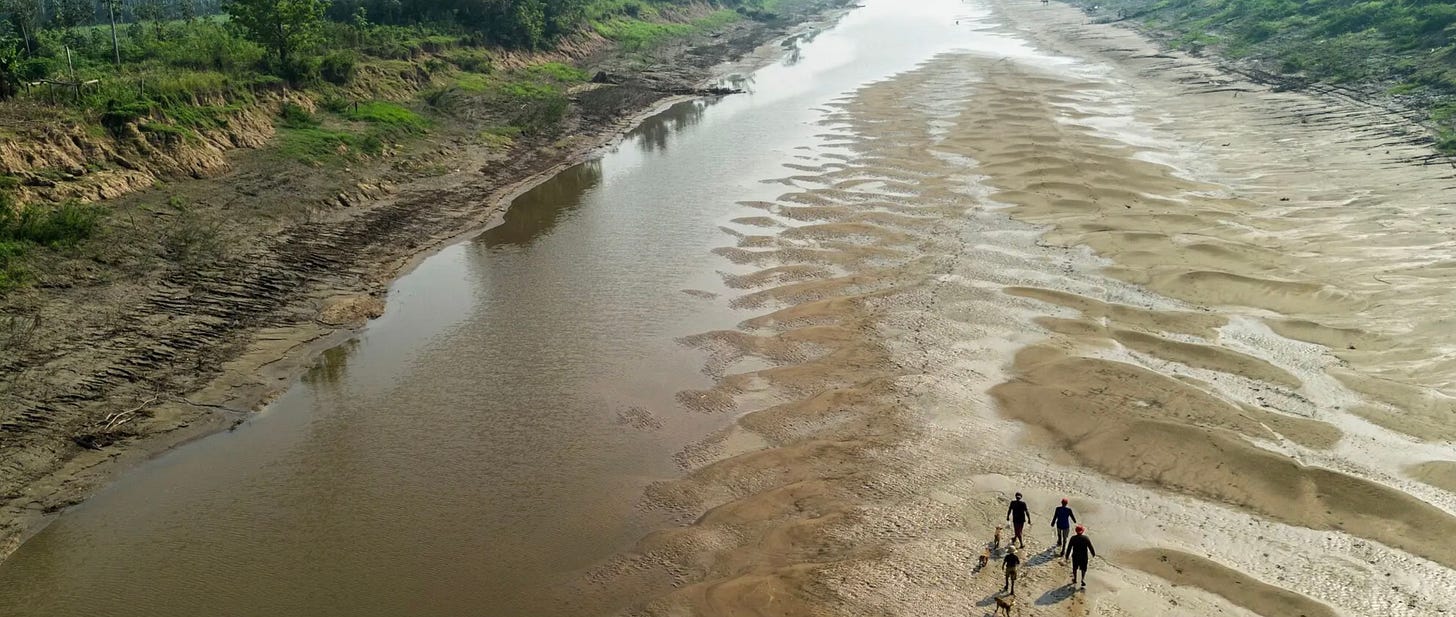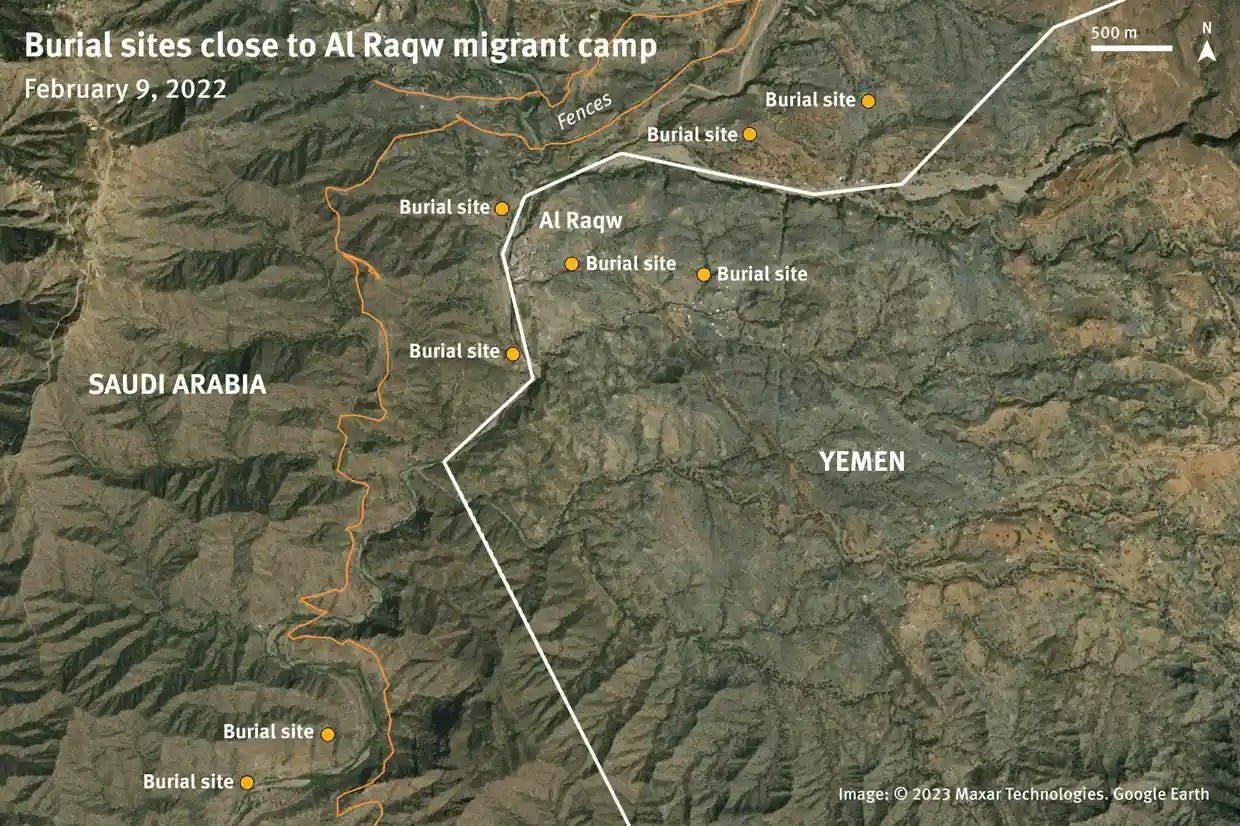1) NorKo in Ukraine: All of the above
NEWSWEEK: Russia Is Running Out of Cemeteries
NYT: For North Korea, War in Ukraine Is a Coveted Chance for Military Practice
NEWSWEEK: North Korean Troops Deserting Ukraine Frontline Days After Arrival
WAPO: Why North Korea is sending soldiers to the Russian front lines
I have already voiced my opinion (pathetic) on Russia needing (apparently) to tap North Korean troops. So, no, I do not take it as some scary sign of the coming apocalypse as rendered by the nefarious CRINK (China, Russia, Iran, North Korea).
Let me count the ways …
First, Russia — somehow despite its vastness — is, per Newsweek, short of graveyards right now:
Russia is running out of cemeteries and crematoriums, a State Duma Deputy Chair has said, amid Pentagon estimates that Moscow has suffered more than 600,000 deaths in its war with Ukraine.
How WWI-ish in tone.
The charitable analysis says Pyongyang sees this as a chance to battle-harden its troops. If true (and I cry BS), then the word hasn’t gotten down to the NorKo troops already deserting the fight.
Hard currency refers to money that is issued by a nation that is seen as politically and economically stable. Hard currencies are widely accepted around the world as a form of payment for goods and services and may be preferred over the domestic currency.
WAPO gets it right: Kim sends them to earn hard currency. He could care less if they come back at all, he just wants the money, because, when you’re as isolated as NorKo, hard currency (like the USD) is EVERYTHING (including proof positive that your economy doesn’t produce anything of genuine value).
Many poorer militaries around the world do the same with UN peacekeeping, which is — as a rule — nice work if you can get it. They basically rent out their soldiers to the UN for a profit, and the experience is, by and large, positive and enhancing of skills.
NorKo can’t do that, obviously, so beggars can’t be choosers.
2) An example of an “inconceivable” succumbing to an “inevitability”
NYT: A Changing Climate Is Scorching the World’s Biggest River
Having grown up on a river (Wisconsin River) that routinely shifts between being too high for safe canoeing and too low for fun canoeing, I know what it’s like to always be aware of its flow. I have rescued my share of canoes that inexperienced sandbar campers left too close to the waterline when they retreated to their tents for the night, only to find them gone the next morning thanks to rising waters. It’s like never turning your back on the ocean’s surf while on a steep shoreline. Take nothing for granted because — every so often — nature surprises with complete indifference to human life.
I feel like we’re seeing a slow-motion version of this with the mega-drought currently drying up the Amazon and its tributaries across South America — in effect, a natural super-highway shut down to virtually all traffic:
The crisis has gridlocked the Amazon, a vital watery superhighway that serves as practically the only way to connect forest communities and move commerce around some of the most remote stretches on the planet.
Faced with a situation that shows no sign of abating, Brazil has resorted to an extraordinary measure that might have been unthinkable not too long ago: making the world’s largest river deeper.
Starting this month, the country plans to begin dredging sections of the river with the aim of ensuring that, even in times of drought, people and goods can keep moving through the rainforest.
Climate change is going to be one long embrace of such “unthinkables.”
This choice is a risky one, with many experts fearing that dredging will unleash large amounts of mercury trapped in the sediment from previous gold-mining operations:
“Sediment is a set of deposits built up over time,” said Adalberto Luis Val, a biologist at the Brazilian Institute for Research of the Amazon in Manaus. “Messing with this sediment is like messing with all of this history.”
Dredging may also increase the river’s turbidity, making the water cloudy and limiting the amount of sunlight that reaches aquatic plants, which they rely on to reproduce.
“The decision to dredge meets a need for communities, for mankind,” Dr. Val said. “But, from an environmental point of view, it is very reckless.”
The danger of iatrogenesis will be ever present: the attempted cure triggering even worse outcomes.
This sort of stress — now, along with the extraordinary and expensive measures required to keep isolated river-based communities intact, naturally raises the question of future abandonment/depopulation of such hard-to-reach areas/communities.
From such small and slow beginnings, we see the potential for massive poleward migration in coming decades. Dredging is a defensive, rear-guard action, not a solution. Eventually, adaptation will often give way to the “move” imperative. Left merely to their own devices (resources), many locals will reach the point of pointlessness (I can’t keep trying to make this work when so many things make it impossible to succeed!).
Then again, humans are resourceful and imaginative, so, in many cases, it may just come down to having enough investment capacity to keep certain areas open for life and business. This is where socializing the risk by North-South integration schemes that dramatically expand the risk pool can be so important.
You don’t everyone from down there to head up here?
Well, then some geopolitical assembly is required.
3) Finally! (I mean, that was fast!)
WAPO: Zillow will now show climate risk data on home listings
You know the drill with identifying (admitting) cars have been “salvaged” or suffered “flood” damage. CARFAX has been doing that for a long time.
Now, it seems, real estate listing services will be doing much the same, with Zillow taking the plunge.
According to Zillow itself, 4/5ths of all buyers “now consider climate risks when shopping for a home.”
The measures? “Flood, wildfire, wind, heat and air quality risks” will be identified. The estimates will project ahead three decades, or the length of your average mortgage.
I’ve been saying that for years in my briefs: once climate change’s scariest projections came within 30 years of today, the threat would have to factored in, and, by that, I mean priced in. We are well within that window today.
4) Hasta la vista, Isla Gardi Sugdub!
AP: Panama prepares to evacuate first island in face of rising sea levels
The emblematic tale:
On a tiny island off Panama’s Caribbean coast, about 300 families are packing their belongings in preparation for a dramatic change. Generations of Gunas who have grown up on Gardi Sugdub in a life dedicated to the sea and tourism will trade that next week for the mainland’s solid ground.
They go voluntarily — sort of.
The Gunas of Gardi Sugdub are the first of 63 communities along Panama’s Caribbean and Pacific coasts that government officials and scientists expect to be forced to relocate by rising sea levels in the coming decades.
Forced off the land and thus denied their means of earning a living.
Get used to that headline across Latin America.
5) The “race for Africa” slowly but inexorably unfolds — and tilts eastward over time

WAPO: Sudan’s civil war fueled by secret arms shipments from UAE and Iran
The PG monarchies’ ongoing rivalry with Iran plays out in Sudan, where UAE and Iran back opposing sides:
Sudanese Armed Forces (SAF): Led by General al-Burhan, this faction represents the traditional military establishment and is supported by Iran.
Rapid Support Forces (RSF): Initially formed from militias involved in the Darfur conflict, RSF aims to secure power for its leader Hemedti. In that struggle, UAE is suspected of supporting the RSF, something it denies but this reporting makes clear is unfolding.
The background to this iteration of civil war in Sudan:
Sudan’s civil war erupted in April 2023 after months of escalating tensions between the military and the RSF, which shared power in ruling the country. Since then, about a fifth of the population has been displaced, and famine looms. U.S.-sponsored peace talks have faltered, while several other countries in the region have stoked the conflict by supplying military support, raising the prospect that the war could spread beyond Sudan’s borders and destabilize its neighbors.
Because Sudan borders the Red Sea, through which 12% of the world’s sea traffic passes, other powers are interested in this conflict, to include Egypt, Saudi Arabia, Turkey, and Russia. Those four plus Iran and the UAE comprise the usual, non-Western suspects that intervene in any Arab world strife. All have naturally been that much more active since America started winding down its interventionary wars across SW Asia in the late 2000s.
“The Horn of Africa has become an arena for competing interests from the Gulf, who are financing and weaponizing local proxies,” said Alexander Rondos, a senior adviser with the Africa Center at the U.S. Institute of Peace. “Whoever controls Sudan, controls the Red Sea.”
Hmm, sort of. The US Navy still has a say.
Story says Egypt tended to back the Sudanese military, only to be bought off by some UAE foreign direct investment ($35B), pushing the army to seek Iranian and Russian help instead.
Besides that maritime chokepoint, the UAE has more specific reasons:
The UAE’s involvement in Sudan is motivated by concerns … over the potential return of Islamists who long flourished in Sudan under former president Omar al-Bashir, diplomats and regional analysts say. The UAE also has extensive interests in Sudan’s gold and agriculture sectors, and longtime ties to RSF commander Gen. Mohamed Hamdan Dagalo, universally known as Hemedti.
It’s interesting to me that, even in backward Sudan, the intervening weapons of choice all seem to be drones.
Low threshold barrier, it would seem, which makes them perfect for a multipolar world full of rising, wannabe great powers.
This is a good snapshot of things to come across Africa, with many of the same players — plus China and increasingly India — getting involved on various sides of civil strife. For the longest time, the Europeans and — more lately — the US have constituted the primary external military presence.
Still, there is no shortage of Eastern great powers who are increasingly willing to work Africa, and their presence will come to rival legacy Western efforts and presence in the years and decades ahead, as Africa “rises” to whatever extent the global economy can accommodate (again, largely as a function of Eastern integration efforts versus that of Western entities).
For now, the numbers still lie with the West, according to this output from Perplexity.ai:
This shift will be subtle and slow, but it will happen. The East’s economic interests in Africa will only increase as the continent’s vast demographic dividend hits mid-century, while those of the aging West will remain minimal.
6) Speaking of drones lowering threshold barriers to … whatever
WSJ: Mystery Drones Swarmed a U.S. Military Base for 17 Days. The Pentagon Is Stumped.
This can’t be good.
Expect many such mysteries and shocks as actors of all stripes accumulate and learn how to use drones.
There will be “gaps” galore.
Corrective legislation will follow disasters, per usual.
7) About time, and about the right place
GUARDIAN: A US university has a new requirement to graduate: take a climate change course
Other than Phoenix and I guess Miami, the most natural suspect is San Diego, home to one of the very best U California sites — top-ten ranked among US public schools. Plus, who doesn’t love San Diego? I do!
Courses must cover at least 30% climate-related content and address two of four areas, including scientific foundations, human impacts, mitigation strategies and project-based learning. About 7,000 students from the class of 2028 will be affected this year.
The logic is undeniable:
“The most important thing is that UC San Diego wants to make sure we’re preparing students for the future that they really will encounter,” says Sarah Gille, a physical oceanographer at Scripps Institution of Oceanography who was part of the committee to create the new plan.
Amen.
Gille says she can stand in front of a class and talk about what the world might look like in 50 or 100 years in terms of temperature increase or sea level rise – “a pretty demoralizing lesson” – but when she ties it to strategic decisions students can make about their own lives, and how to pursue opportunities in the future, “it can become an empowering lesson too”.
This is why I wrote America’s New Map.
The driver is Gen Z’s rising interest in climate change. I know. I have four.
States from California to Connecticut and New Jersey are now requiring that kids learn about the climate crisis in grade school classrooms.
Arizona State University has also implemented a new sustainability requirement for graduation this year. Universities such as Columbia, Harvard and Stanford are taking the climate focus a step further and have created entire schools devoted to the issue.
Then there is DeSantis’ Florida trying to censor all such thinking and drive it from the schools. It doesn’t get much stupider than that.
Teach the children well. Give them a future they can work and not just dread.
8) The Ukrainian solution-set — simplified
KYIV POST: ‘Either Nukes or Alliance’ – Zelensky Raises Specter of Ukraine Becoming Nuclear Again
H/T Andy Barnett
After the dissolution of the Soviet Union in 1991, Ukraine inherited a significant nuclear arsenal, making it the third-largest nuclear power at that time. This included approximately 1,900 strategic nuclear warheads and various delivery systems. Ukraine never had operational control over these weapons, as Russia maintained authority over their launch sequences and operational capabilities.
In 1994, Ukraine agreed to relinquish its nuclear arsenal in exchange for security assurances from Russia, the United States, and the United Kingdom, formalized in the Budapest Memorandum, which included Belarus and Kazakhstan making the same move to disarm. This agreement stipulated that Ukraine would transfer its nuclear warheads to Russia and become a non-nuclear weapon state under the Treaty on the Non-Proliferation of Nuclear Weapons (NPT).
Naturally, looking back now, Kyiv feels like it made a mistake.
Would some nukes on Ukraine’s territory have stopped Putin from deciding to go in? Questionable, but it certainly would have been a very different ramp-up than the one we experienced going all the way back to Russia’s seizure of Crimea in 2014.
By 1996, all of Ukraine's nuclear warheads had been transferred to Russia, and the last strategic delivery vehicle was eliminated by 2001.
Fast forward to Zelensky looking for an exit ramp, a key component of which MUST be admitting Ukraine into NATO (my opinion), and it’s a natural temptation to pose that request as an either-or calculation: either get Ukraine under NATO’s nuclear umbrella or Ukraine will construct its own.
How serious a threat? Unless done secretly and then unveiled, any observed movement down that path would present a huge and easily justifiable target for Russia, in addition to amping up its continued warfighting rationale.
Still, Zelensky’s demand makes clear Ukraine’s exit requirements: whatever they are going to be asked to give up in terms of territory, then whatever remains HAS to be integrated by NATO/EU.
Nothing less is acceptable or — frankly — worth entertaining.
9) Another sad example of murdering migrants en masse
REUTERS: UN seeks probe into reported mass killing of Afghans migrating to Iran
H/T Jeff Itell.
Add it to the list, with the enduring Einsatzgruppen vibe being the tendency to buy the dead in mass graves right along the border.
Here’s an overview of graves along the Saudi-Yemen border, where experts estimate Saudi forces kill up to 1,000 migrants in any one year (based on investigations that estimated 7-800 Ethiopian climate migrants were murdered across a recent 12-month period):
The evidence remains underground and yet it is building up.
One can only assume, per the past example, that the security forces strip the dead of all their valuables before bulldozing them over.
This is the reality of world featuring ever increasing migrations of people being met by governments determined to protect their borders: routine mass murder.
Security experts now designate any conflict creating more than 1,000 deaths in a year to be a de facto “war,” which means this century’s North-South wars are well underway.
10) Oops! Ukraine did it again!
AAA: It Happened Again. Russian Troops Gathered For Training. A Ukrainian Drone Watched—And A Ukrainian Rocket Streaked Down.
Watch the vid and enjoy the metal (both ordinance and music soundtrack).
Killing Russian troops while they’re training. That is NASTY!
We never had a chance!
No kidding.
Use to be there was the BOOM and there was “left of BOOM” (because, as we all know, time moves from left to right on a PPT slide and if you can’t accept that, then you must be some communist lefty).
In the Before Time, you could do whatever you wanted left of BOOM because it was relatively safe until the BOOM came along.
Now, with drones, your opponent can move the BOOM to the left! That’s like sacking your QB during pre-game warm-ups!
Why bother going to the front when you can die in basic training? Perhaps without even getting out of your cot?
The Military Singularity looms.
Fair has nothing to do with it.
11) Putin’s next target
NYT: Moscow Roils a Country on the Edge of Europe and Russia
Moldova, a former Soviet republic, is strategically located between Ukraine and Romania. Its recent steps towards European Union (EU) membership, particularly after the EU initiated accession negotiations in June 2024, spook the ever vigilant Putin, determined not to lose custody of any more Soviet “kids” to the West.
Playing the role of Ukraine’s Russian-dominated eastern provinces in this play is Transnistria. Transnistria, a breakaway region of Moldova, declared independence during the early 1990s following the collapse of the Soviet Union. Since then, it has maintained a pro-Russian stance, supported by an estimated 1,500 Russian troops stationed there since a military intervention in 1992. The region is naturally characterized by a significant ethnic Russian population and a strong reliance on Russian economic support.
Per the NYT story, Moldova is “gearing up for a contentious referendum on whether to amend its Constitution to enshrine the ‘irreversibility’ of its ‘European course’.”
Them’s fighting words, as far as the Kremlin is concerned.
Another damn kid wants to live with mom, and the abusive ex-dad is, per usual, thinking he’d rather beat the child into submission than let it go.
Sunday’s vote on changing the Constitution represents the culmination of a decades-long tug of war over Moldova’s direction between East and West. Each side has invested heavily in swaying the outcome. While the European Union has done this openly through support for Moldova’s economy and its government, Russia has sought to keep the country within its orbit through furtive funding for anti-government activities and what officials and international technology giants describe as a broad campaign of disinformation against the E.U.
So Europe offers economic support and Russia offers dirty tricks.
Quelle surprise.
12) Why every vote matters
WAPO: Trump has vowed to gut climate rules. Oil lobbyists have a plan ready - As companies fall short on methane emission reductions, a top trade group has crafted a road map for dismantling key Biden administration rules
FOREIGN AFFAIRS: The True Dangers of Trump’s Economic Plans — His Radical Agenda Would Wreak Havoc on American Businesses, Workers, and Consumers
NYT: What China’s Leaders Grasp About Another Trump Term
WAPO: How more young voters could reshape Congress
The going back danger is very real with Trump, effectively banishing US global leadership to the past and setting up the country for economic and environmental turmoil of the highest order.
All of our competitors and enemies will welcome Trump back into the White House, knowing his rule will cripple the country far better than any conflict.
From the NYT story cited:
Nobody grasps this better than China’s leaders. They saw his term as an accelerant of what they believe to be American decline, and not without reason. Mr. Trump focused on U.S. commodity exports instead of long-term manufacturing strength. He alienated allies and partners, mishandled the pandemic response and repeatedly showed disregard for democratic norms. On China policy, he routinely put personal gain over America’s interests and undermined important steps his staff members took to compete with Beijing. As a result, Mr. Trump was widely mocked by Chinese citizens, who nicknamed him “Chuan Jianguo” (“Build-the-Nation Trump” — the “nation” being China). His administration led President Xi Jinping of China to declare that the world was undergoing “great changes unseen in a century” as America fell from pre-eminence.
I always say that America gets the leadership it deserves, but the world deserves better, as do younger Americans.
If those Americans under 40 voted at the same rate as those over 40, Congress would be decidedly blue. It’s just a matter of caring about your future.
Because, if we vote, we win.




















First